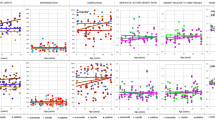Abstract
Purpose
Incisive suture is a suture classically described on the oral face of the palate in fetuses and young children. The aim of our study was to describe the evolution of the incisive suture in human fetuses and to evaluate the incidence of this suture in a population of young children under 4 years, to determine if there is a possibility of improving the anterior growth of the maxilla, by stimulation of this suture.
Methods
One hundred and thirty CT scan images of patients aged from birth to 48 months have been studied and nine fetal palates aged from 18 to 26 weeks of development, have been scanned using high-resolution X-ray micro-computed tomography
Results
The CT scan images of patients showed that an incisive suture was present in 33/130 cases (25,4%). All the patients with a suture were under 2 years old. The fetal palate study showed that the suture was present in the inferior aspect of the palate (oral cavity) in all cases. The incisive suture increased from 18 to 24 weeks. At 26 weeks it stopped growing although the intercanine length increased. Considering the closure of the suture in a vertical plane, our study on fetuses has shown that the incisive suture is closing from its superior side (nasal side) to its inferior side.
Conclusions
Considering all these results it appears to us that the incisive suture is partially ossified after birth, it cannot be stimulated by orthodontic appliances.






Similar content being viewed by others
References
Augier M (1932) Sur le développement du prémaxillaire humain. C R Assoc Anat 27:18–28
Barteczko K, Jacob M (2004) A re-evaluation of the premaxillary bone in humans. Anat Embryol 207:417–437
Behrents RG, Harris EF (1991) The premaxillary-maxillary suture and orthodontic mechanotherapy. Am J Orthod Dentofac Orthop 99:1–6
Bennett KG, Heindricks HM, Thurston TE, Kasten SJ, Vercler CJ, Buchman SR (2017) The protruding maxilla: is our current approach the right answer? J Craniofac Surg 28:459–462
Bittermann GKP, de Ruiter AdP, Janssen NG, Bittermann AJN, van der Molen AM, van Es RJJ, Rosenberg AJWP, Koole R (2016) Management of the premaxilla in the treatment of bilateral cleft of lip and palate: what can the literature tell us? Clin Oral Invest 20:207–217
Carmody KA, Mooney MP, Cooper GM, Bonar CJ, Siegel MI, Dumont Smith ERTD (2008) Relationship of premaxillary bone and its suture to deciduous dentition in nonhuman primates. Cleft Palate Craniofac J 45:93–100
Delaire J (1974) Considérations sur l’accroissement du prémaxillaire chez l’Homme. Rev Stomatol Chir Maxillofac 75:951–970
Delaire J (1997) Maxillary development revisited: relevance to the orthopaedic treatment of Class III malocclusions. Eur J Orthod 19:289–311
El-Kassaby MA, Abdelrahman NI, Abbass IT (2013) Premaxillary characteristics in complete bilateral cleft lip and palate: a predictor for treatment outcome. Ann Maxillofac Surg 3:11–19
Haskell BS, Farman AG (1985) Exploitation of the residual premaxillary-maxillary suture site in maxillary protraction: an hypothesis. Angle Orthod 55:108–119
Kraus BS, Decker JD (1960) The prenatal inter-relationships of the maxilla and premaxilla in the facial development of man. Acta Anat 40:278–294
Latham RA (1970) Maxillary development and growth: the septo-premaxillary ligament. J Anat 107:471–478
Lisson JA, Kjaer I (1997) Location of alveolar clefts relative to the incisive fissure. Cleft Palate Craniofac J 34:292–296
Mareille B, Bar D (1999) The premaxilla in Neanderthal and early modern children: ontogeny and morphology. J Hum Evol 37:137–152
Nijo BJ, Kjaer I (1993) The development and morphology of the incisive fissure and the transverse palatine suture in the human fetal palate. J Craniofac Genet Dev Biol 13:24–25
Ross RB, Johnston MC (1967) The effect of early orthodontic treatment on facial growth in cleft lip and palate. Cleft Palate J 4:157–164
Trevizan M, Consolaro A (2017) Premaxilla: an independent bone that can base therapeutics for middle third growth! Dental Press J Orthod 22:21–26
Trevizan M, Filho PN, de Oliveira Braga Franzolin S, Consolaro A, (2018) Premaxilla: up to which age it remains separated from the maxilla by a suture, how often it occurs in children and adults, and possible clinical and therapeutic implications: study of 1,138 human skulls. Dental Press J Orthod 23:16–29
Vacher C, Copin H, Sakka M (1999) Maxillary ossification in a series of six human embryos and fetuses aged from 9 to 12 weeks of amenorrhea: clinical applications. Surg Radiol Anat 21:261–266
Vacher C, Sakka M, Dauge MC (2001) Incisive suture (fissure) in the human fetus: radiographic and histologic study. Cleft Palate Craniofac J 38:292–296
Witzig JW, Spahl TJ (1987) The clinical management of basic maxillofacial orthopedic appliances, vol I. Mechanics. PSG Publishing, Littleton, pp 2266–2268
Winters JC, Hurvitz DJ (1995) Presurgical orthopedics in the surgical management of unilateral cleft lip and palate. Plast Reconstr Surg 95:755–764
Wood NK, Wragg LE, Stutteville OH, Oglesby RJ (1969) Osteogenesis of the human upper jaw: proof of the nonexistence of a separate pre-maxillary centre. Arch Oral Biol 14:1331–1339
Acknowledgements
This work was supported by grants from University of Paris and the Fondation de la Recherche Médicale (FRM DGE20111123012). In vivo imaging was performed at the Life Imaging Facility of Paris University (Plateforme Imageries du Vivant), supported by France Life Imaging (grant ANR-11-INBS-0006) and Infrastructures Biologie-Santé
Funding
None.
Author information
Authors and Affiliations
Contributions
PN: protocol development, data analysis, manuscript writing. ME: protocol development, data collection. JS: protocol development. LS: protocol development. CV: protocol development, manuscript writing and editing.
Corresponding author
Ethics declarations
Conflicts of interest
We have no conflict of interest to declare.
Additional information
Publisher's Note
Springer Nature remains neutral with regard to jurisdictional claims in published maps and institutional affiliations.
Rights and permissions
About this article
Cite this article
Nicol, P., Elmaleh-Bergès, M., Sadoine, J. et al. Incidence and morphology of the incisive suture in CT scanning of young children and human fetuses. Surg Radiol Anat 42, 1057–1062 (2020). https://doi.org/10.1007/s00276-020-02521-8
Received:
Accepted:
Published:
Issue Date:
DOI: https://doi.org/10.1007/s00276-020-02521-8




